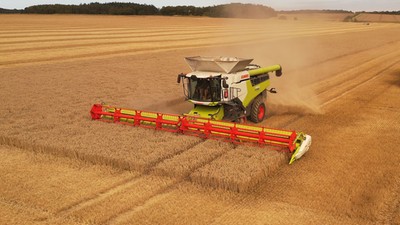
On farm assessments conducted this harvest have shown that while the latest LEXION 8900 may be one of the highest capacity and most powerful combines on the market, it is also one of the most fuel efficient with use as low as 0.95 litres/tonne harvested while maintaining a harvesting rate of 94 tonnes/hour.
In addition, analysis of TELEMATICS data for all LEXION 8900 machines operating in the UK showed an overall average fuel consumption of just 66 litres for all engine hours. A further comparison between the previous top-of-the-range LEXION 780 and its new LEXION 8800 equivalent shows a fuel saving from the latter of 3 litres for all engine hours, worth £378*.
Harvest 2020 proved a challenge for many farmers, especially in the north of England and Scotland where the on-farm assessments were carried out. Yet despite the testing conditions and at times high moisture contents, the LEXION 8900 still recorded fuel consumption figures for its 790hp MAN engine as low as 0.95 litres/tonne, or just 40 pence/tonne*.
Over the course of three days in late August/early September, the LEXION 8900TT harvested a total of 141ha of wheat and 34ha of oats on two farms, one near Alnwick in Northumberland and the other near Perth. Conditions were far from ideal. The assessment followed a period of wet weather, with the result that moisture contents ranged from 15.7% to 19.1% and wheat yields also ranged from 7.84t/ha up to 12.57t/ha.
“We wanted the assessment as far as possible to realistically reflect the efficiency of the new LEXION 8900 in a true farm environment, so included harvesting the headlands and the conditions certainly reflected that and were typical of what many farmers experienced this year,” states Adam Hayward, the CLAAS UK Product Manager for Combine Harvesters who operated the LEXION 8900.

In the first assessment in Northumberland, the LEXION 8900 harvested 107ha of wheat. Conditions meant that harvesting was only possible in the afternoon and evening. However, it was here that the true potential of the LEXION 8900 in a high yielding crop was realised. In a 38ha crop yielding 12.57t/ha, the LEXION was able to maintain an overall average throughput of 94t/ha, including the headlands, using just 11.98 litre/ha or 0.95l/t. By comparison, in a 27ha block of wheat yielding 7.84t/ha, fuel use was just 8.88l/ha or 1.15l/t.
Following these on-farm assessments, using data recorded by TELEMATICS, CLAAS UK have also studied overall fuel use for all LEXION 8900 combines working in the UK last harvest. This showed a total fuel consumption of just 66 litres for all engine hours, so including idling, road travel, etc in addition to working hours. By comparison, total usage for all the previous top-of-the-range 625hp LEXION 780 machines working this year was 68l/hr, while its new equivalent, the LEXION 8800 (653hp), used just 65l/hr. Over the 300 engine hours a combine typically works in a season, this equates to a fuel cost saving of about £378*.
Total all engine hours fuel use (litres/hour)
| LEXION 8900 (790hp) | LEXION 8800 (653hp) | LEXION 780 (625hp) | |
| Total fuel use | 66 litres | 65 litres | 68 litres |
“These figures clearly show how fuel efficient the new LEXION 8000 series is even in testing conditions,” says Adam Hayward. “Fuel is a major running cost. While the LEXION 8900 may be one of the most powerful combines on the market, these assessments demonstrate how modern technology, such as the new APS SYNFLOW threshing system with its larger 755mm diameter drum, Dynamic Power and Dynamic Cooling all help to also make it one of the most fuel efficient combines on the market.”
* Red diesel at 42 pence/litre (1st September 2020)